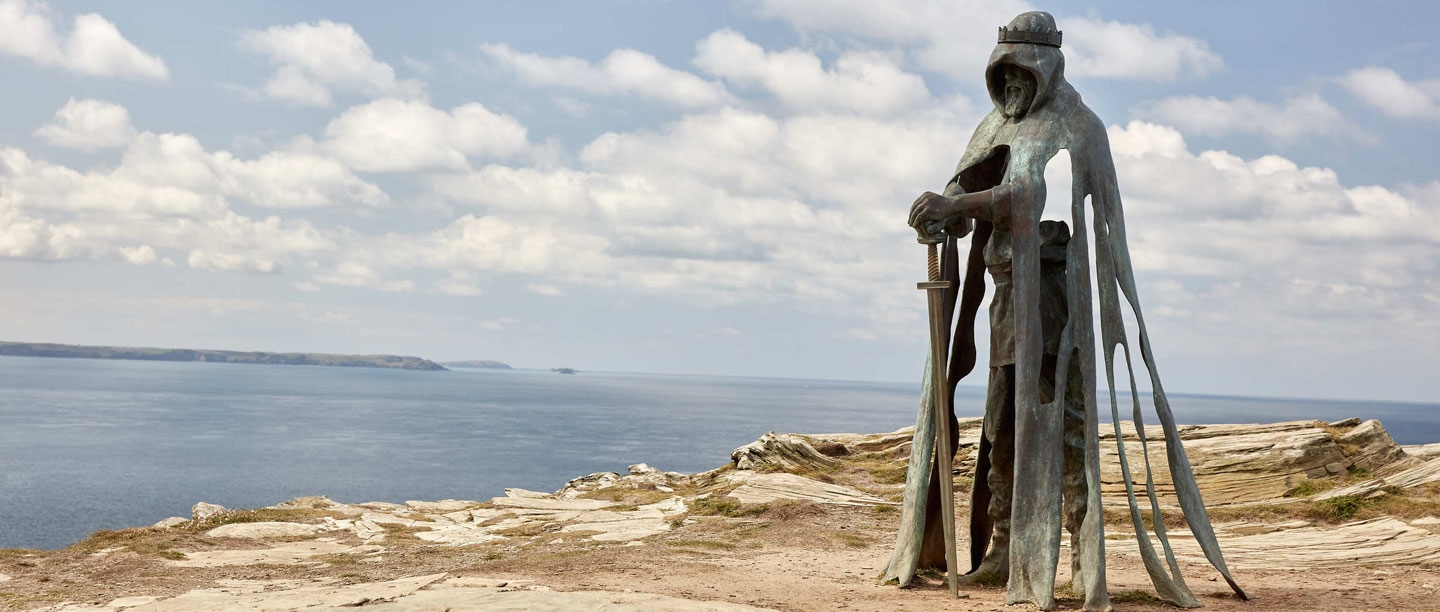
Myths and Legends
Test your knowledge of myths and legends with our quiz. Click on each question to reveal the answer.
-
Q. 1 - It is claimed that a warrior, with his sword and bugle horn beside him, lies in a charmed sleep in the vault of which remote castle on the Northumberland coast?
Answer: Dunstanburgh Castle
Crowning a headland on the rugged Northumberland coast, and reachable only on foot, remote and spectacular Dunstanburgh Castle has naturally inspired legends. One claims that a warrior, with his sword and bugle horn beside him, lies in a charmed sleep in a castle vault. The best-selling Georgian gothic horror writer 'Monk' Lewis added sensationally to this, with a story about a lady trapped in a crystal tomb, guarded by two giant skeletons.

-
Q. 2 - Hylton Castle in Sunderland is reported to be troubled by a 'hob'. But what is a hob?
Answer: Hob is an archaic word meaning sprite or hobgoblin
The splendid medieval gatehouse tower of Hylton Castle was once part of a much bigger mansion. It was troubled by a household spirit or 'hob', the Cauld (cold) Lad, who could often be heard lamenting that it would be centuries before anyone would release him from his bondage.

-
Q. 3 - According to legend, which saint, who was the abbess of Whitby, drove snakes away from the area by casting them over the cliffs?
Answer: St Hild
St Hild was the abbess of Whitby in the 7th century. Later legends say that Whitby was plagued by snakes. Hild was asked to intervene, and she drove the serpents away by quoting Jesus in the Gospel of Mark: 'Be removed and cast into the sea.' The snakes fell over the cliffs and smashed their heads, and then more prayers from Hild miraculously turned their heads to stone. You can still find the remains of these snakes on the beach below the abbey – although they’re actually fossilised ammonites that are millions rather than hundreds of years old.
-
Q. 4 - 12th-century writer Geoffrey of Monmouth claimed Stonehenge was a reconstructed stone circle called the Giants’ Dance that was transported from which country: Belgium, Scotland, France or Ireland?
Answer: Ireland
We now know that Stonehenge was begun in about 3000BC, and developed gradually over 1,000 years. But the 12th-century writer Geoffrey of Monmouth declared it was built in about AD 485, in a single day. The British King Aurelius wanted a striking war memorial to people killed by the Saxons. So Merlin told him of a wonderful stone circle in Ireland, called the Giants' Dance. Merlin quickly shifted the massive stones. Loaded on to boats, they were taken to Salisbury Plain, where Merlin arranged them exactly as they'd been in Ireland.

-
Q. 5 - A phantom coach drawn by four fire-breathing horses is said to have been seen flying over which 14th-century barn in Worcester?
Answer: Leigh Court Barn
A phantom coach, drawn by four fire-breathing horses, supposedly used to be seen flying up and over Leigh Court Barn. It was driven by the spirit of 'Old Colles', condemned to do so for a highway robbery
-
Q. 6 - According to legend, how did a bishop decide where to build Salisbury Cathedral?
Answer: He ordered an archer to shoot an arrow from Old Sarum's ramparts and he built the cathedral where it fell
In around 1220 Bishop Richard Poore decided to build a new cathedral. According to legend, he decided its site by ordering an archer to shoot an arrow from Old Sarum's ramparts – or, some say, he shot the arrow himself. Where the arrow fell, he built what is now Salisbury Cathedral. But there's a problem with this tradition. Salisbury Cathedral is almost two miles from Old Sarum. So it's nearly nine times further away than even the strongest trained archer with the mightiest medieval longbow could shoot the lightest 'flight' arrow.
-
Q. 7 - Who assumes the title of the legendary ‘King of Piel’ on a small island off Barrow-in-Furness today?
Answer: The landlord of the island's Ship Inn
In June 1487, Lambert Simnel's army landed to seize the throne of England from King Henry VII. Really the 10-year-old son of an Oxford craftsman, Lambert claimed to be Edward, Earl of Warwick, who Henry's Yorkist enemies regarded as the rightful king of England. Lambert invaded Piel with an army of around 8,000 soldiers but soon moved on to total defeat. Lambert was pardoned and spent the rest of his life as a kitchen servant and then a falconer at the Tudor court. He'd only ever been 'King of Piel'. There's still a King of Piel today – the landlord of the island's Ship Inn, who takes on the title with the pub.
-
Q. 8 - In around 1400, an anonymous monk wrote down the stories of how many ghosts said to have been encountered at Byland Abbey in North Yorkshire, 26,15,12 or 4?
Answer: 12
One of Yorkshire's great Cistercian monasteries, Byland Abbey displays the striking ruins of a cathedral-sized church. Here, in about 1400, an anonymous monk wrote down 12 extraordinary Latin ghost stories. They're very matter-of-fact reports, often including the names of eye-witnesses and the exact spots around Byland where they'd encountered ghosts, sometimes in broad daylight.

-
Q. 9 - Can you identify the Tudor queen (pictured), who is said to have secretly given birth to a viper fathered by the devil while taking refuge at Framlingham Castle?
Answer: Mary Tudor
In July 1553, Henry VIII's daughter Mary Tudor took refuge from enemies who challenged her right to the throne in Framlingham Castle. Wildly enthusiastic supporters rallied to her, and she was proclaimed queen. Her popularity didn't last long. Determined to enforce her strong Roman Catholic beliefs on England, Queen Mary burnt at the stake around 300 men and women who wouldn't give up their Protestant faith. In late Victorian times, Suffolk people believed that Bloody Mary had secretly given birth to a viper at Framlingham Castle. This was either a punishment for the execution of a popular vicar or because she had sold herself to the Devil.
-
Q. 10 - What ladies are said to haunt the ruins of Berry Pomeroy Castle in Devon?
Answer: The Blue Lady and the White Lady
Deep in woodland overlooking a picturesque valley, the medieval defences and dramatic shell of an Elizabethan mansion at Berry Pomeroy look just the place for spooks. So Georgian and Victorian fiction writers created a whole bunch of them, based on the mistaken belief that the castle was a Norman fortress, scene of many dark deeds. Before long, the imaginary Blue Lady and the White Lady, the ghostly riders and the murdered baby from these made-up tales began to materialise as 'real' ghosts.

-
Q. 11 - What animal was said to guard the severed head of St Edmund at Bury St Edmunds Abbey?
Answer: A wolf
St Edmund was captured by invading Vikings in AD869 but refused to give up his Christian faith. So the Viking leader Ivarr the Boneless had him tied to a tree and shot full of arrows, 'like the spines of a hedgehog'. Then his ribs were cut and bent away from his spine. Finally, as he still called on Christ, Edmund's head was hacked off and hidden in dense thorn bushes. Edmund's followers discovered the head guarded by a huge white wolf: the wolf shadowed them until the saint's head and body were brought together, and then vanished.

-
Q. 12 - Who might you find sitting on the Countless Stones of Little Kits Coty in Kent if you try and count them?
Answer: The Devil
Kit's Coty House is a prehistoric tomb chamber, with three huge sarsen stones topped by a massive capstone. Little Kit's Coty was once similar, but now it's a jumble of fallen Countless Stones. They've been attracting visitors and rival legends for centuries. Both monuments allegedly have strange powers. If you walk round it three times at full moon, Kit's Coty will swallow up anything placed on the capstone. And don't try to count the Countless Stones or you might find the Devil sitting on one of them.
-
Q. 13 - A witch disguised as what long-eared animal is said to haunt Bolingbroke Castle in Lincolnshire?
Answer: A hare
Before the castle was demolished during the Civil War, local tax officials used to meet there once a year. But their meetings were often upset by 'a certain spirit in the likeness of a hare', which ran between their legs and sometimes tripped them up. Once they chased it into a castle cellar, which had no means of escape, yet though they searched every corner, they couldn't find it. Another time hounds were sent in after it but shot out yelping with fright.
-
Q. 14 - According to the 13th-century writer Gervase of Tilbury, a swineherd working for Peveril Castle's lord found what in the vast Peak Cavern that sits below it?
Answer: Broad open country, bathed in summer sun, where people were gathering the harvest
Peveril Castle is one of the oldest Norman castles in England. Its Domesday Book name was 'Peak's Arse', from the vast Peak Cavern that lies almost directly beneath it, and was believed to be an entrance to Hell. According to the 13th-century writer Gervase of Tilbury, a swineherd working for the castle's lord found something more enchanting there. On a freezing midwinter day, he lost a sow that was about to have piglets, and guessed she'd strayed into the cavern. Not daring to tell his master he'd abandoned a valuable animal, he overcame his fears and ventured in. After wandering through dark passages, he found himself to his amazement in broad open country, bathed in summer sun, where people were gathering the harvest.

-
Q. 15 - What did workmen supposedly find in the walls of Thornton Abbey in North Lincolnshire while demolishing the abbey?
Answer: A room containing the body of a monk
The story goes that Sir Vincent Skinner demolished the abbey to build himself a Jacobean mansion on the site. But ‘when it was finished, it fell quite down to the bare ground, without any visible cause, and broke in pieces all the rich furniture that was therein.' It's also said that workmen demolishing the abbey found a room containing the body of a monk, sitting at a table with book, pen and paper, all of which fell to ashes when touched.
-
Q. 16 - A fiddler is said to have disappeared in a secret passage linking Binham Priory with what nearby abbey?
Answer: Walsingham Abbey
A secret passage is said to link Binham with nearby Walsingham. It was patrolled above ground by a ghostly black-clad monk – possibly one of several mad or wicked priors from the monastery's troubled history – who seemed to be searching for something. A local fiddler called Jimmy Griggs, with his dog Trap, volunteered to explore the passage, fiddling all the way so that his friends could trace his progress. But when they reached Fiddler's Hill the music suddenly stopped, and Trap came dashing out terrified. Jimmy Griggs was never seen again, and some said the monk had got him.
-
Q. 17 - What is said to have been spotted in the waters of Falmouth Bay below Pendennis Castle in Cornwall?
Answer: A sea monster
In 1975–76, many people reported sighting a sea monster up to 18 metres long, usually said to have two humps, a very long snaky neck and a small head, rather like the Loch Ness monster. Years later, a local joker admitted making up his sightings, persuading other hoaxers to back his story and even sending blurred fake photos of the Falmouth Bay 'morgawr' – Cornish for 'sea giant' – to local newspapers.

-
Q. 18 - According to legend, how are local people said to have saved Wenlock Priory’s bells and treasures before Henry VIII closed it down?
Answer: They buried them under a haunted hill and in a church graveyard
Stories still firmly believed in the 20th century told how local people saved the priory's bells and treasures before Henry VIII closed it down. They buried the bells under a hill haunted by the ghost of a 'conjuror' or wizard; no thief would dare to dig for them there. But over the years the hiding place was forgotten, until a farmer tried to plough the hill. When his plough horses broke into a sweat and refused to move, people knew there was something uncanny beneath. So the vicar dug and found the bells, and hung them in the parish church. The priory's treasures, meanwhile, were buried in the holy ground of Easthope's church graveyard, with a death curse laid on them to make doubly sure.
-
Q. 19 - Tintagel Castle is said to have connections with which doomed lovers?
Answer: Tristan and Isolde
Dragon-slaying Tristan was the nephew of Cornish King Mark, who lived at Tintagel. He went to Ireland to collect his uncle's bride, the beautiful Isolde, famed for her healing skills. But both Tristan and Isolde drank a magic love potion by mistake, and fell hopelessly in love. Isolde married Mark all the same, yet continued to love Tristan in secret. Eventually the king found out, and Tristan was exiled to Brittany, where he was badly wounded. So he sent for Isolde to heal him; her ship was to show white sails if she was aboard. Tristan's jealous new wife told him its sails were black, and he died of despair; Isolde then died of a broken heart.

-
Q. 20 - Tudor visitors travelled to Dover Castle in Kent to see the alleged skull of which of King Arthur’s famous knights?
Answer: Sir Gawaine
The story goes that Gawaine was badly wounded in the head in single combat against Sir Lancelot. He'd only partly recovered when Arthur's wicked son Mordred seized the English throne. Arthur defeated Mordred at Dover but, during the fighting, Gawaine was struck again on the old wound. He died at Dover Castle, and was buried in the castle chapel. And there, wrote Sir Thomas Malory in the 1460s, 'all men may still see the skull of him, and the same wound is seen that Sir Lancelot gave him in battle.'


